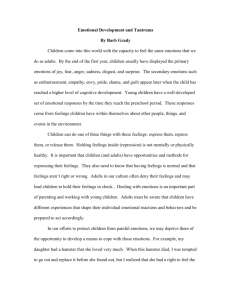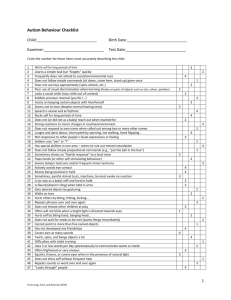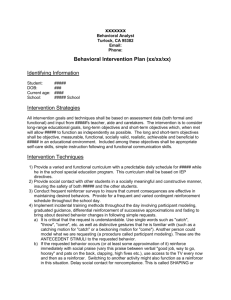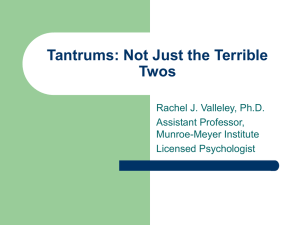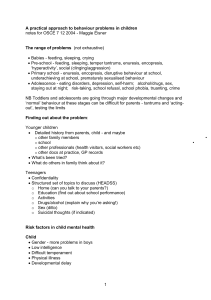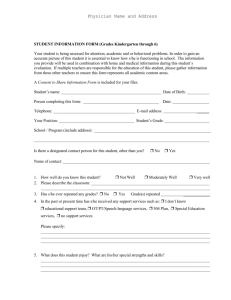Temper Tantrums: Guidelines for Parents and Teachers
advertisement
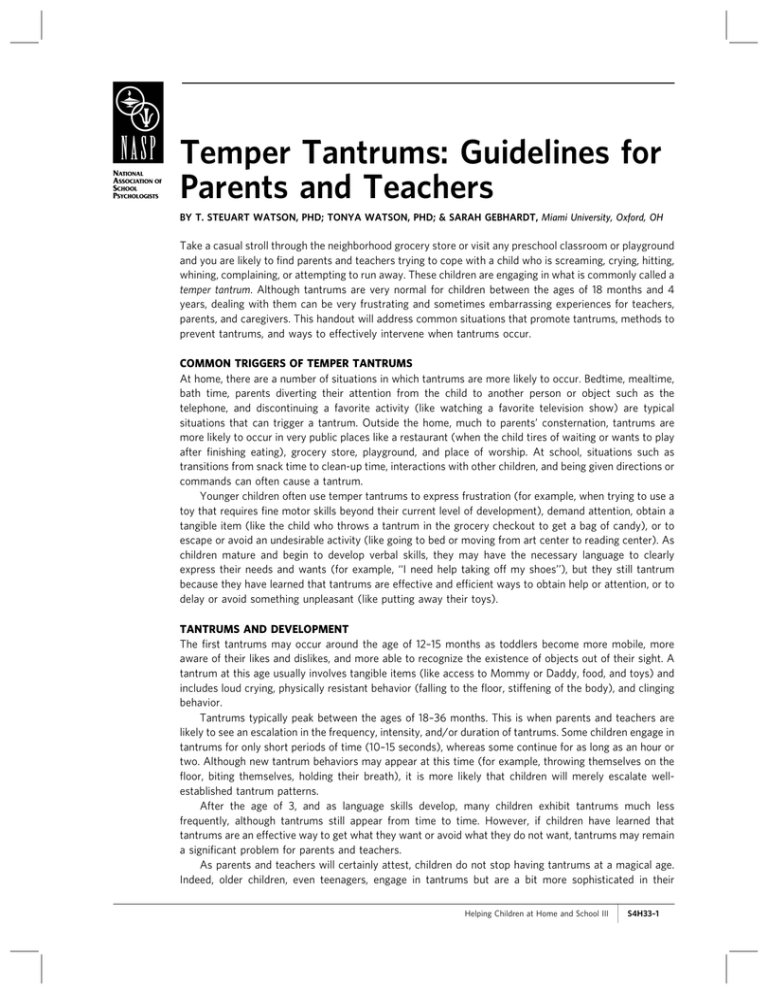
Temper Tantrums: Guidelines for Parents and Teachers BY T. STEUART WATSON, PHD; TONYA WATSON, PHD; & SARAH GEBHARDT, Miami University, Oxford, OH Take a casual stroll through the neighborhood grocery store or visit any preschool classroom or playground and you are likely to find parents and teachers trying to cope with a child who is screaming, crying, hitting, whining, complaining, or attempting to run away. These children are engaging in what is commonly called a temper tantrum. Although tantrums are very normal for children between the ages of 18 months and 4 years, dealing with them can be very frustrating and sometimes embarrassing experiences for teachers, parents, and caregivers. This handout will address common situations that promote tantrums, methods to prevent tantrums, and ways to effectively intervene when tantrums occur. COMMON TRIGGERS OF TEMPER TANTRUMS At home, there are a number of situations in which tantrums are more likely to occur. Bedtime, mealtime, bath time, parents diverting their attention from the child to another person or object such as the telephone, and discontinuing a favorite activity (like watching a favorite television show) are typical situations that can trigger a tantrum. Outside the home, much to parents’ consternation, tantrums are more likely to occur in very public places like a restaurant (when the child tires of waiting or wants to play after finishing eating), grocery store, playground, and place of worship. At school, situations such as transitions from snack time to clean-up time, interactions with other children, and being given directions or commands can often cause a tantrum. Younger children often use temper tantrums to express frustration (for example, when trying to use a toy that requires fine motor skills beyond their current level of development), demand attention, obtain a tangible item (like the child who throws a tantrum in the grocery checkout to get a bag of candy), or to escape or avoid an undesirable activity (like going to bed or moving from art center to reading center). As children mature and begin to develop verbal skills, they may have the necessary language to clearly express their needs and wants (for example, ‘‘I need help taking off my shoes’’), but they still tantrum because they have learned that tantrums are effective and efficient ways to obtain help or attention, or to delay or avoid something unpleasant (like putting away their toys). TANTRUMS AND DEVELOPMENT The first tantrums may occur around the age of 12–15 months as toddlers become more mobile, more aware of their likes and dislikes, and more able to recognize the existence of objects out of their sight. A tantrum at this age usually involves tangible items (like access to Mommy or Daddy, food, and toys) and includes loud crying, physically resistant behavior (falling to the floor, stiffening of the body), and clinging behavior. Tantrums typically peak between the ages of 18–36 months. This is when parents and teachers are likely to see an escalation in the frequency, intensity, and/or duration of tantrums. Some children engage in tantrums for only short periods of time (10–15 seconds), whereas some continue for as long as an hour or two. Although new tantrum behaviors may appear at this time (for example, throwing themselves on the floor, biting themselves, holding their breath), it is more likely that children will merely escalate wellestablished tantrum patterns. After the age of 3, and as language skills develop, many children exhibit tantrums much less frequently, although tantrums still appear from time to time. However, if children have learned that tantrums are an effective way to get what they want or avoid what they do not want, tantrums may remain a significant problem for parents and teachers. As parents and teachers will certainly attest, children do not stop having tantrums at a magical age. Indeed, older children, even teenagers, engage in tantrums but are a bit more sophisticated in their Helping Children at Home and School III | S4H33–1 approach—yelling, name-calling, slamming doors, and so on. When intervening with older children, the same general strategies provided below apply. Just remember that older children and adolescents are more practiced in their tantrum skills, are likely to hold out for longer periods of time, and can rapidly escalate into destructive or dangerous behavior. PREVENTING TANTRUMS Tantrums tend to occur when children lack daily routines, when they are expected to change activity without warning, or when they lack the skills needed to meet adult expectations. Schedules and Routines One of the most basic ways to prevent tantrums is to provide schedules and routines for children to follow. Consistent schedules allow children to expect routine changes in their environment and to adjust their behavior without having a tantrum. This does not mean that children require excessively rigid routines, but that they need to recognize that certain things occur at about the same time each day and in roughly the same sequence. Inflexible schedules, on the other hand, might prompt tantrums when there are inevitable interruptions or changes. Prompts and Transitions When children are required to move from one activity to another, a highly effective technique is to give reminders about the upcoming change. For instance, you might tell your child, ‘‘When this cartoon is over, it will be time to take a bath.’’ Doing so helps to avoid a tantrum by alerting your child that a bath is upcoming, but that he or she will be allowed to finish whatever he or she is doing at that time. The same general rule applies for teachers. Before abruptly ending one activity and moving to another, give a 5-minute warning and then a 2-minute warning to help children move fluidly and without disruption from one activity to the next. Skill Building When you discover that children are having tantrums because they lack certain skills, you can teach them the skills they need. For instance, a child who is trying to assemble a puzzle but is unable to do so begins screaming and crying. In this case, the child lacks two skills: puzzle assembling and asking for help. If this type of situation typically results in a tantrum, teaching the child to ask for assistance will help prevent future tantrums. Parents or teachers might also then analyze the task the child is attempting to perform and consider modifying the level of difficulty (offering an easier puzzle) or directly teaching the skills needed to succeed S4H33–2 | Temper Tantrums (sorting puzzle pieces by colors, identifying the edge pieces, and so on). There are a number of other strategies that help to promote ‘‘tantrum lite’’ environments and teach social skills at the same time. Provide meaningful tasks. Perhaps one of the most effective strategies is giving children meaningful, appropriately challenging tasks to do as opposed to endlessly repetitive, unchallenging tasks. It is important to keep in mind that the skills required by the task should be things the child is capable of doing. Otherwise, the child may have a tantrum out of frustration and/or to escape the task. Teaching coping skills. Another strategy that will help to reduce tantrums is directly teaching children how to handle frustration (that is, what to do when they become frustrated). Giving children difficult-to-perform tasks and actively monitoring them and coaching them on what to do (for example, teaching your child to say, ‘‘This is really difficult and I am getting frustrated. Can you show me what to do?’’ or ‘‘I need help’’) is an excellent means of directly teaching this valuable skill. Of course, you have to follow up by monitoring your child, prompting your child to use the skill, and then providing reinforcement when he or she follows through. Choices and reinforcement. Two additional strategies that will come in handy include giving children choices between two equally allowable activities and reinforcing the display of nontantrum behaviors when a tantrum was expected. Children who are given choices are less likely to resort to tantrums because they are engaging in an activity that they have chosen. In addition, they are learning decision-making skills. INTERVENING WITH TANTRUMS Effective intervention involves understanding what not to do as well as what to do. The Do Nots Before considering what to do when a child has a tantrum, it is far more important to remember what not to do. The two cardinal do-nots for dealing with tantrums are: N Do not try to reason with the child, get the child to see the error of his or her ways, or coax the child into good behavior. N Do not give the child what he or she wants (for example, a preferred food at mealtime) or allow the child to escape or avoid what he or she does not want (for example, picking up toys in the classroom). The likely immediate result of violating the first rule is a worsening of the tantrum (probably due to the reinforcing effects of attention). Violating the second rule doubles the reinforcing power of the tantrum. Giving the child what he or she wants will likely end the tantrum (much to the relief of parents and teachers) but will also teach the child that having a tantrum is an effective means of getting his or her way. When Children Have Tantrums Faced with a child who is having a tantrum, parents and teachers have several options, including ignoring the behavior, minimizing attention to tantrums by differentially reinforcing appropriate behavior, and using brief time-out procedures. Ignoring behavior. If a child is in the throes of a tantrum, the best strategy to use, if possible, is to completely ignore the behavior while not allowing the child to obtain anything he or she may be seeking or get out of anything he or she may want to avoid. For example, do not ignore a tantrum when doing so allows the child to go to the kitchen and get into the cookie jar. At school, if the teacher has instructed all children to sit on their mats, do not allow misbehavior to result in avoidance of mat time. Differential reinforcement. A very effective strategy for dealing with tantrums is to utilize differential reinforcement. That is, pay attention when the child is not having a tantrum (for example, when the child is complying with requests or playing quietly) and minimize attention when the child is having a tantrum. This is easier said than done, particularly for parents who are in a public area with a screaming child. In such instances, it is probably better to (a) head off a tantrum before it starts through redirection or a high rate of reinforcement for even the tiniest display of appropriate behavior; or (b) remove the child from the environment as quickly as possible (that is, intervene when the tantrum is at a relatively mild level) and return when the child has finished the tantrum. Although removing the child from the environment may actually reinforce the tantrum, it usually saves the parent a great deal of embarrassment and teaches the child to have a mild tantrum in public as opposed to a full-blown debacle complete with such behaviors as writhing on the floor, screaming, and kicking. Brief time-out. For the parent or teacher who wants to be a bit more active in intervening with tantrums, a brief time-out procedure is recommended. As soon as the tantrum begins, tell the child, ‘‘No _______ (crying, whining, screaming, kicking). Time-out.’’ Escort the child to a time-out location (an area without any opportunities for attention or fun—not a punitive situation) with no further explanation and no interaction during the entire time-out period. After the child has been quiet for approximately 10–15 seconds, say, ‘‘Now you are being quiet. Time-out is over.’’ It is important that the child learns to become quiet in time-out so the procedure can be used in public with minimal disruption. It is equally important to remember that if a command or direction was the likely cause of the tantrum, the parent or teacher should reissue the command when time-out is over so the child does not learn that time-out is an escape. The sequence should be repeated until the child complies with the request. RECOVERING FROM TANTRUMS Following a tantrum: N Do not discuss the tantrum or admonish the child. N Make sure to reinforce any appropriate behaviors with brief periods (about 3–5 seconds) of attention. It is reasonable to assist children or teach them new skills after a tantrum if they were being asked to do something of particular difficulty (for instance, a teacher who asks a child with poor fine motor skills to color a picture) or something they did not have the skill to do. WHEN TO SEEK HELP If parents and teachers use these strategies consistently but still see an increase in the intensity, frequency, or duration of a child’s tantrums, they should consult the school psychologist, a behavior specialist, or the child’s physician. Persistent tantrums as well as other inappropriate behaviors might indicate the need for a comprehensive evaluation. An immediate referral should be made if the child starts exhibiting self-harming behaviors or becomes destructive toward others and property. In later childhood and adolescence, a referral should be considered if the child seems excessively moody, withdrawn, or depressed. CHILDREN WITH DISABILITIES While all children typically exhibit temper tantrum behaviors until age 4, it is not uncommon for children with disabilities such as autism, Asperger syndrome, Down syndrome, and attention deficit hyperactivity disorder (ADHD), among others, to continue having temper tantrums in later childhood. Many of the same techniques previously described for working with younger children have also proven successful in working with children with disabilities, particularly those techniques that focus on reinforcement and skill enhancement. Helping Children at Home and School III | S4H33–3 RECOMMENDED RESOURCES For School Personnel Luiselli J. K., & Murbach, L. (2002). Providing instruction from novel staff as an antecedent intervention for child tantrum behavior in a public school classroom. Education and Treatment of Children, 25, 356–365. Ostrosky, M. M., Jung, E. Y., Hemmeter, M. L., & Thomas, D. (2003). Helping children understand routines and classroom schedules: What works briefs series. Available: http://www.vanderbilt.edu/csefel/ briefs/wwb3.pdf Wilder, D. A., Chen, L., Atwell, J., Pritchard, J., & Weinstein, P. (2006). Brief functional analysis and treatment of tantrums associated with transitions in preschool children. Journal of Applied Behavior Analysis, 39, 103–107. S4H33–4 | Temper Tantrums For Parents Jensen, W. R., Rhode, G., & Neville, M. H. (2003). The tough kid parent book: Practical solutions to tough childhood problems. Frederick, CO: Sopris West. KidsHealth, Temper tantrums: http://www.kidshealth. org/parent/emotions/behavior/tantrums.html Murkoff, H. (2008). What to expect in the toddler years. New York: Workman Publishing. T. Steuart Watson, PhD, is Chair and Professor of Educational Psychology; Tonya Watson, PhD, is a Visiting Assistant Professor in the Department of Family Studies; and Sarah Gebhardt is an EdS student in the School Psychology program, all at Miami University, Oxford, OH. E 2010 National Association of School Psychologists, 4340 East West Highway, Suite 402, Bethesda, MD 20814—(301) 657-0270

